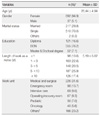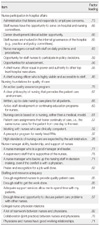1. Aiken LH, Clarke SP, Sloane DM, Lake ET, Cheney T. Effects of hospital care environment on patient mortality and nurse outcomes. Journal of Nursing Administration. 2008. 38:223–229. doi:
10.1097/01.NNA.0000312773.42352.d7.
2. Aiken LH, Clarke SP, Sloane DM, Sochalski JA, Busse R, Clarke H, et al. Nurses' reports on hospital care in five countries. Health Affairs. 2001. 20:43–53. doi:
10.1377/hlthaff.20.3.43.
3. Aiken LH, Patrician PA. Measuring organizational traits of hospitals: The revised nursing work index. Nursing Research. 2000. 49:146–153.
4. Aiken LH, Sloane DM, Lake ET, Sochalski J, Weber AL. Organization and outcomes of inpatient AIDS care. Medical Care. 1999. 37:760–772.
5. Aiken LH, Smith HL, Lake ET. Lower medicare mortality among a set of hospitals known for good nursing care. Medical Care. 1994. 32:771–787.
6. Cho SH, June KJ, Kim YM, Park BH. Changes in hospital nurse staffing after implementing differentiated inpatient nursing fees by staffing grades. Journal of Korean Academy of Nursing Administration. 2008. 14:167–175.
7. Clarke SP, Sloane DM, Aiken LH. Effects of hospital staffing and organizational climate on needlestick injuries to nurses. American Journal of Public Health. 2002. 92:1115–1119.
8. Er KS, Hur HK, Kim KK, Cho YJ, Kim EH, Kim SJ. The relationship between job characteristics, job satisfaction, and intents to leave among hospital nurses. Clinical Nursing Research. 2004. 9:81–92.
9. Hair JF, Tatham RL, Anderson RE, Black W. Multivariate data analysis. 1998. 5th ed. New Jersey: Prentice Hall Inc.
10. Harrington D. Confirmatory factor analysis: Pocket guides to social work research methods. 2009. New York: Oxford University Press.
11. Kang KN. Nurses' practice environment, nursing professionalism, career commitment, and turnover intention in the small-medium sized hospital. 2010. Seoul: Ewha Womans University;Unpublished master's thesis.
12. Kang SY, Seo Y.J. Determination of organizational creativity at nursing care units of university hospitals in Korea. Korean Journal of Hospital Management. 2004. 9:1–20.
13. Kang SY, Um YR, Han SS. A professional nursing practice environment and its impact on nurses' task motivation. Journal of Korean Academy of Nursing. 2005. 35:353–361.
14. Ko HJ. Nurse work environment, job satisfaction and intention to leave among nurses in a general hospital. 2010. Seoul: Hanyang University;Unpublished master's thesis.
15. Kramer M, Hafner L. Shared values: Impact on staff nurse job satisfaction and perceived productivity. Nursing Research. 1989. 38:172–177.
16. Lake ET. Development of the practice environment scale of the nursing work index. Research in Nursing and Health. 2002. 25:176–188. doi:
10.1002/nur.10032.
17. Lake ET. The nursing practice environment: measurement and evidence. Medical Care Research and Review. 2007. 64:104S–122S. doi:
10.1177/1077558707299253.
18. Lake ET, Friese CR. Variations in nursing practice environments: Relation to staffing and hospital characteristics. Nursing Research. 2006. 55:1–9.
19. Lee GH. Methodology of social science. 2001. Seoul: Bobmunsa.
20. Lee SM. The effect of job characteristics and personal factors on work stress, job satisfaction and turnover intention. The Journal of Nurses Academic Society. 1995. 25:790–806.
21. Leiter MP, Spence Laschinger HK. Relationships of work and practice environment to professional burnout: Testing a causal model. Nursing Research. 2006. 55:137–146.
22. Liou SR, Cheng CY. Using the practice environment scale of the nursing work index on Asian nurses. Nursing Research. 2009. 58:218–225.
23. McClure ML, Poulin MA, Sovie MD, Wandelt MA. Magnet hospitals: Attraction and retention of professional nurses. 1983. Kansas City, MO: American Nurses Association.
24. Merenda PF. A guide to the proper use of factor analysis in the conduct and reporting of research: Pitfalls to avoid. Measurement and Evaluation in Counseling and Development. 1997. 30:156–164.
25. Peterson N, Krebs J, Erspamer HS. Texas health resources 2004 nurses' survey. 2004. Minneapolis, MN: Satisfaction Performance Research Center.
26. Polite DF, Beck CT. Nursing research: Generating and assessing evidence for nursing practice. 2008. 8th ed. Philadelphia, PA: Lippincott Williams & Wilkins, a Wolters Kluwer Business.
27. Sovie MD. The economics of magnetism. Nursing Economics. 1984. 2:85–92.
28. Thomas-Hawkins C, Denno M, Currier H, Wick G. Staff nurses' perception of the work environment in freestanding hemodialysis facilities. Nephrology Nursing Journal. 2003. 30:169–183.






 PDF
PDF ePub
ePub Citation
Citation Print
Print





 XML Download
XML Download